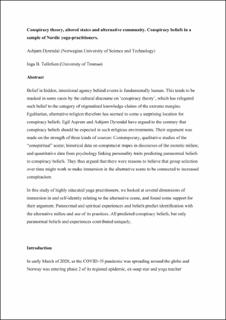| dc.contributor.author | Dyrendal, Asbjørn | |
| dc.contributor.author | Tøllefsen, Inga Bårdsen | |
| dc.date.accessioned | 2023-03-09T13:12:54Z | |
| dc.date.available | 2023-03-09T13:12:54Z | |
| dc.date.created | 2023-01-27T15:38:44Z | |
| dc.date.issued | 2023 | |
| dc.identifier.isbn | 9780367637705 | |
| dc.identifier.uri | https://hdl.handle.net/11250/3057395 | |
| dc.description.abstract | Belief in hidden, intentional agency behind events is fundamentally human. However, the cultural discourses on ‘conspiracy theory’, which has relegated such beliefs to the category of stigmatised knowledge claims of the extreme margins, can mask the ubiquity of such beliefs. Egalitarian, alternative religion therefore has seemed to some a surprising location for conspiracy beliefs. Egil Asprem and Asbjørn Dyrendal have argued to the contrary that conspiracy beliefs should be expected in such religious environments. Their argument was made on the strength of three kinds of sources: contemporary, qualitative studies of the ‘conspiritual’ scene; historical data on conspiracist tropes in discourses of the esoteric milieu; and quantitative data from psychology linking personality traits predicting paranormal beliefs to conspiracy beliefs. They thus argued that there were reasons to believe that group selection over time might work to make immersion in the alternative scene a predictor of increased conspiracism. In this study, we looked at Nordic survey data on 161 mostly highly educated yoga practitioners and found some support for their argument. We looked at several dimensions of immersion in and self-identity relating to the alternative scene. Paranormal and spiritual beliefs and experiences predict increased identification with the alternative milieu and use of its practices. Increased identification with the milieu and all the factors furthermore predicted increased conspiracy beliefs. However, only paranormal beliefs and experiences contributed uniquely. | en_US |
| dc.language.iso | eng | en_US |
| dc.publisher | Routledge | en_US |
| dc.relation.ispartof | Religious Dimensions of Conspiracy Theories. Comparing and Connecting Old and New Trends | |
| dc.title | Conspiracy Theory, Altered States, and Alternative Community: Conspiracy Beliefs in a Sample of Nordic Yoga-Practitioners | en_US |
| dc.title.alternative | Conspiracy Theory, Altered States, and Alternative Community: Conspiracy Beliefs in a Sample of Nordic Yoga-Practitioners | en_US |
| dc.type | Chapter | en_US |
| dc.description.version | acceptedVersion | en_US |
| dc.source.pagenumber | 165-184 | en_US |
| dc.identifier.doi | 10.4324/9781003120940 | |
| dc.identifier.cristin | 2116859 | |
| cristin.ispublished | true | |
| cristin.fulltext | postprint | |
| cristin.qualitycode | 2 | |
